Logboat |
A thick log, often oak, hollowed out creating a long narrow canoe. In Europe they
were made from c 8000 BC until the early 20th century. Some replicas have
been made in modern time, both of Mesolithic logboats and of Medeival logboats. The oldest European logboats (dugouts) were usually carefully built, slender, elegant, thin-walled and light. However, logboats from historic times are often crude, rough and heavy. Perhaps the logboat had lost status in historic times, when the planked boat dominated. Logboats built as outriggers are still used in India and other places. More info. |
 |
Skin boat |
The skin boat has a skin tied around a wooden frame. The boat type was never very widespread, but may have been one of mankind's earliest attempts of boatbuilding. A modern example is the traditional corracle in Ireland. |  |
Reed boat |
Small reed boats (made of thick grass) may have been used in the Mesopotamian River area and Egypt (papyrus) around 5000 BC or earlier. The Kuwait find could be just such a boat. Reed boats are still made and used on the Titicaca Lake in South America. | |
Egyptian ship |
The first Egyptian sailing ships existed around 3000 BC or even earlier. They were
used on the Nile River, which was ideal for primitive sailing vessels. The wind on the Nile is
usually from the north, so if they wanted to go south they just raised the sail on the double mast.
And if they wanted to go north, they just lowered the sail and drifted with the river. Simple! The ship was made of planks assembled with the mortise and tenon method or sewn together using rope. Ship drawing by Axel Nelson. The largest Egyptian ship recorded is Queen Hatsheput's obelisque barge from the 15th century BC, transporting two obelisques, each weighing 350 tons and 100 m tall. The best preserved Egyptian ships are the Cheops ships. |
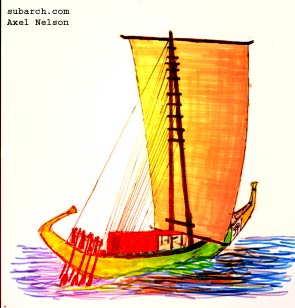 |
Trireme |
The trireme was the quickest ship in antiquity. It was a narrow war
galley, as opposed to the wider cargo ships of the same time. It used sail for
transportation, but only oars in battle. As the Greek name implies, the trireme had three rows of
rowers on each side, dveloped from earlier Greek and Phoenician biremes. It was a hi-tech racer that
could exceed 10 knots, chase and sink an enemy with its ram.
The hull was a compact special construction of light wood, e g pine tree, assembled by
mortise and tenon fashion. When it was not in action,
it was kept on a slipway in a roofed boat house.
During the battle of Salamis in 480 BC, the Greeks had 380 ships and defeated the Persian navy of 600 ships. About half of the Greek navy may have been triremes. Photo by J.S. Illsley, University of Wales. A Greek replica, the Olympias, was built in 1987. Ram photo by J.S. Illsley. |
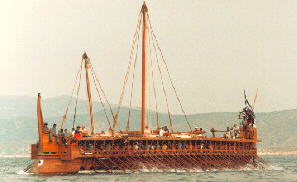 |
Roman merchant ship (corbita) |
The hull was assembled with the mortise
and tenon method. The masts carried square sails. The ship was steered by two side rudders
connected to each other. The reconstruction drawing of the c 40 m long
Mahdia ship (c 100 BC) is made by Dr Olaf H÷ckmann, Deguwa. The largest known Roman ship was the 95 m long "Caligula's giant ship". |
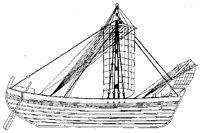 |
Junk |
Classic Chinese sailing vessel of ancient unknown origin, still in wide use.
High-sterned, with projecting bow, the junk carries up to five masts on which are set square sails
consisting of panels of linen or matting flattened by bamboo strips. Each sail can be spread or
closed at a pull, like a venetian blind.
According to Chinese tradition, admiral Zheng He led several expeditions during 1405-1433 AD, using giant junks, to explore the world. Some of the ships were reported to have been over 100 m long. Ref: EncyclopŠdia Britannica. |
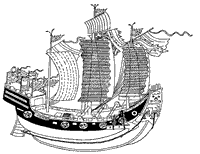 |
Viking ship |
It had a clinker-built hull assembled with iron rivets, using the shell-first method. It had one mast with a square yard sail. At insufficient wind it was rown with oars. The quarter rudder (side rudder) was on the right (starboard) side. The ship was always open and undecked. Produced from 8th to 13th century, and commonly used in Northern Europe. Long narrow ships were made for warfare, and sturdy wide skips (knarr) were made for cargo. Several modern replicas have been made. | |
Dhow |
Traditional Arab ship. The word dhow has been applied by Europeans to many
different types of Arab traditional ships. What they all have in common is the triangular lateen sail
and a carvel-built hull.
Source: E.L. Cornwell (ed), An Illustrated History of Ships (London 1979). |
|
Cog |
Sturdy one-masted north European Medieval merchant ship with a flat bottom. Commonly used in Northern Europe during c 1200-1400 AD. A few modern replicas have been made. More info. |
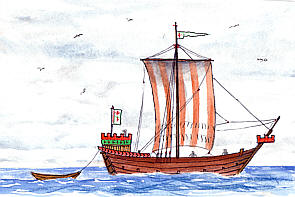 |
Galley |
This rowing warship was common in Antiquity, such as the trireme. But galleys appeared again in the 16th-18th centuries, using a triangular lateen sail for transportation to the "battlefield". Galleys were used as late as in the Swedish-Russian battles of 1790. The illustration shows a Russian 18th century galley. |
 |
Caravel |
Small Spanish and Portuguese merchant ship in the 15th and 16th centuries. See painting. | |
Nao / Nau |
Spanish and Portuguese merchant ship in the 15th and 16th centuries. In Portuguese the ship is called nau. In Spanish it's nao. The corresponding ship type in English is carrack (described below). More info. |
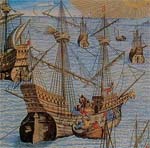 |
Carrack |
West European ship in the 15th and 16th centuries, similar to the nau. It was usually a merchant ship, like the Swedish wreck Ringaren, but the warship Mary Rose is also a carrack. | |
Galleon |
Large west European ship in the 16th century. In Spain and Portugal, it was developed from the nao. Armed and often used for long-distance trade. Link. | |
Flute ship |
Merchant ship of Dutch origin. Common in Northern Europe during the 17th and 18th centuries. The hull was carvel-built, the bow was flat, the stern was rounded and the deck was much narrower than the hull below. The illustration is made by Axel Nelson. More info. |
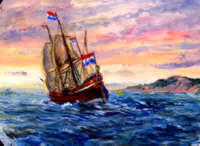 |
74-gun ship |
This type of large two-decked warship was developed in France,
and eventually became a European standard ship of the line from the mid-18th century until the end of the Napoleon wars in 1815.
The design had a good balance between firepower and sailing qualities.
The largest guns were usually 36-pounders.
Some 74-gun ships were still used in action as late as 1841, in
China and off Syria.
The last surviving 74-gun ship was probably
HMS Implacable (ex Dugay-Trouin) which was scuttled
in 1949.
Source: E.L. Cornwell (ed), An Illustrated History of Ships (London 1979) and Jean Boudriot, Le vaisseau de 74 canons (Collection archÚologie navale franšaise 1973/1977). |
|
Schooner |
In Northern Europe a schooner was usually a two or three-masted sailing ship with a
carvel built hull and a gaff rig on all masts.
But there were larger schooners elsewhere. One example is the American ship Thomas W Lawson, that carried seven masts. |
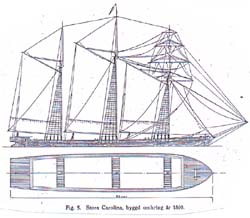 |
Brig |
The brig is a two-masted sailing ship where both masts are square rigged. The rear
mast carries a gaff sail as well. More about brigs.
The earliest brigs usually had a separate mast for the gaff sail, placed together with the rear mast. Such brigs were called snow brigs. |
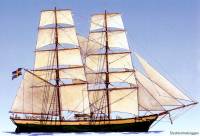 |
Bark |
Three or four-masted ship with square rig on fore and main mast. | |
Paddle steamer |
The earliest steamships were paddle steamers. Screw propellers came later on. Have a
look at the Jura,
Erik Nordewall,
and Hirondelle. The painting by Reinhardt Grosch shows Erik
Nordewall. |
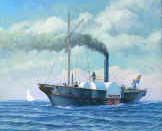 |
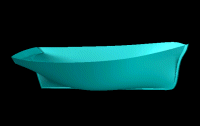 Back to Replicas & Shipbuilding
Back to Replicas & Shipbuilding Back to Nordic Underwater Archaeology
Back to Nordic Underwater Archaeology